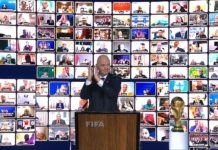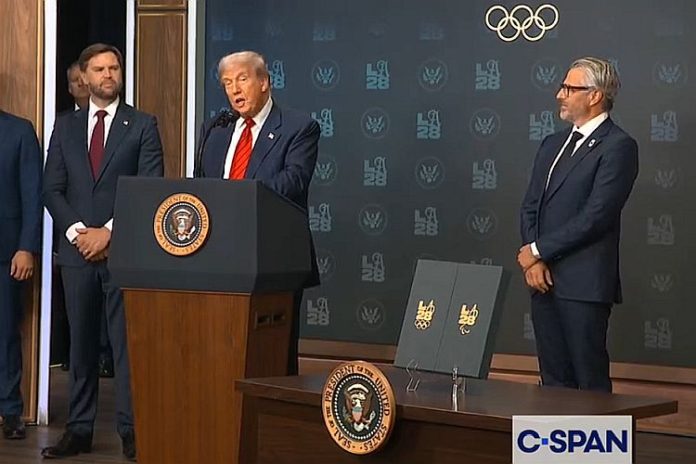★ The Sports Examiner: Chronicling the key competitive, economic and political forces shaping elite sport and the Olympic Movement.★
★ To get the daily Sports Examiner Recap by e-mail: sign up here! ★
≡ LOS ANGELES 2028 & TRUMP ≡
Doomed! Trump has taken over the 2028 Olympics! The Feds will run everything in 2028! All is lost! Waaah!
Those were some of the reactions seen on social media, and that I received yesterday from friends and some TSX readers in the aftermath of U.S. President Donald Trump signing an Executive Order establishing a White House Task Force on the 2028 Olympic and Paralympic Games.
Even an interview request from a local news channel.
My reply: calm down. Just calm down. And stay calm.
Having helped organize and stage 20 multi-day, multi-site events, including multiple Olympic Games, let’s be clear about this: the U.S. government must be involved for the Games to work. Period.
And it is much better to have Washington involved early than late, and it is:
● The 2028 Games were declared a National Special Security Event (NSSE) in June 2024, the furthest-in-advance such a designation has ever been granted.
The designation placed the U.S. Secret Service in the lead role for “design and implementation of the operational security plan.” That was more than a year ago and security officials from local, regional, state and Federal agencies have been in continuing discussions ever since about how to plan for security and who will do what and when.
● H.R.1, the “One Big Beautiful Bill Act” provided $1 billion in security funding for the 2028 Games, to be managed by the Federal Emergency Management Agency (FEMA).
● Now, Trump signed the Task Force Executive Order, which informs the entire Federal bureaucracy that (1) the success of the 2028 Games is a priority and (2) there is one responsibility with three primary areas of focus:
“[C]oordinate Federal planning and response related to the security, transportation, and entry/exit processes for the Games.”
It’s not to run the Games, or replace the LA28 organizing committee, or do a bunch of other things that make no sense. It’s about those things which only the Federal government can do – national security and access control into the U.S. – and something the Federal government can help with, namely transportation.
The other instructions in the order are about coordination and planning:
“(b) support interagency cooperation and information-sharing with State and local partners;
“(c) identify legal, logistical, or regulatory barriers that could impede effective Federal support for the Games and recommend timely solutions;
“(d) assist in the planning and implementation of visa processing and credentialing programs for foreign athletes, coaches, officials, and media personnel; and
“(e) ensure operational readiness across law enforcement, counterterrorism, transportation, and emergency response functions.”
There is nothing new in all this, in fact, the same sort of White House Task Force was created for the last Los Angeles Olympic Games, in 1981, following a meeting of President Ronald Reagan and Los Angeles Olympic Organizing Committee President Peter Ueberroth, Executive Vice President/General Manager Harry Usher and Glenn Wilson, the LAOOC’s coordinator for coin and philatelic programs.
Reagan’s Deputy Chief of Staff Michael Deaver headed the task force, whose directive was to ensure coordination within the Federal government, eliminate bottlenecks that could hurt the organizing effort and support the overall security effort.
Same thing. And with excellent results in 1984.
In fact, the U.S. government has been more and more involved in each Olympic Games since. A U.S. General Accounting Office report in 2000 described prior Olympic spending by the U.S. government, which included:
● For Los Angeles 1984, $50 million (in 1984 dollars) was allocated for security support for the Games and $45 million was actually appropriated.
● For Atlanta 1996, the Federal government spent about $609 million (in 1999 dollars) on the Games, including $96 million for safety and security measures ($36 million for the Department of Defense). Most of the money was spent on highway and other infrastructure projects; of the $609 million total, $17 million was spent on spectator transportation (including the provision of 1,000 military drivers).
● For Salt Lake City 2002, Federal spending of $1.254 billion was planned, with $1 billion for highway and transit infrastructure projects already planned, but accelerated. Spending on the Games for security was expected to cost $161 million, plus $77 million on spectator transportation systems.
The $254 million in Games support costs had ballooned to $342 million by the time of a 2001 GAO update (2001 dollars shown at $341 million due to rounding):
● $185 million for Safety and Security
● $106 million for Transportation
● $27 million for Venue Construction
● $19 million for Staging and Operations
● $4 million for Housing and Infrastructure Support
The security cost went up considerably due to added protections after the terrorist incidents of 11 September 2001. No follow-up GAO report on costs compiled after the 2022 Games is available.
Those who worry about armed soldiers walking the streets of Los Angeles during the Olympic Games conveniently forget – or don’t know – that U.S. soldiers were a significant presence on the ground in and around Salt Lake City’s 2002 Winter Games, which opened just five months after the 9/11 terrorist attacks on New York and Washington, D.C. in 2001.
The $1 billion already allocated for 2028 is far from the last money the U.S. will spend for security, or to ramp up the visa section of the State Department, and money will be allocated – at some point – for transportation.
The Los Angeles Metropolitan Transportation Authority has asked for $3.2 billion in support for the Games and some other projects and received nothing from the Biden Administration and so far, nothing from the Trump Administration. Who will run what in the public transportation sector is yet to be determined, but the Department of Transportation is now on notice to help make the Games work.
Federal assistance will be needed elsewhere, for instance on weather support and forecasts, especially for the sailing venues, and the U.S. Chief of Protocol, the recently-confirmed Monica Crowley, will have her hands full with more than 100 heads of state expected to attend some part of the 2028 Games. There are venue sites on lands controlled by some element of the U.S. government. Will there be a commemorative coin and stamp program?
There’s a lot to do and organizing success will boil down to the three “Cs”: coordination, cooperation and communication. Much easier to say than to do at this scale, as I have seen myself.
The sooner such efforts are started, and relationships developed, especially for events as large as the Olympic and Paralympic Games and with an organization as insanely complex as the U.S. government, the better.
For those who can’t stand the idea of the Trump Administration involved with the 2028 Games, there is plenty of time left to worry. For those who know that the Federal government has to be involved, Tuesday’s Executive Order is a good thing, a very good thing, and on time.
So, for now, stay calm.
Rich Perelman
Editor
★ Receive our exclusive, weekday TSX Recap by e-mail by clicking here.
★ Sign up a friend to receive the TSX Recap by clicking here.
★ Please consider a donation here to keep this site going.
For our updated, 699-event International Sports Calendar for 2025, 2026 and beyond, by date and by sport, click here!























